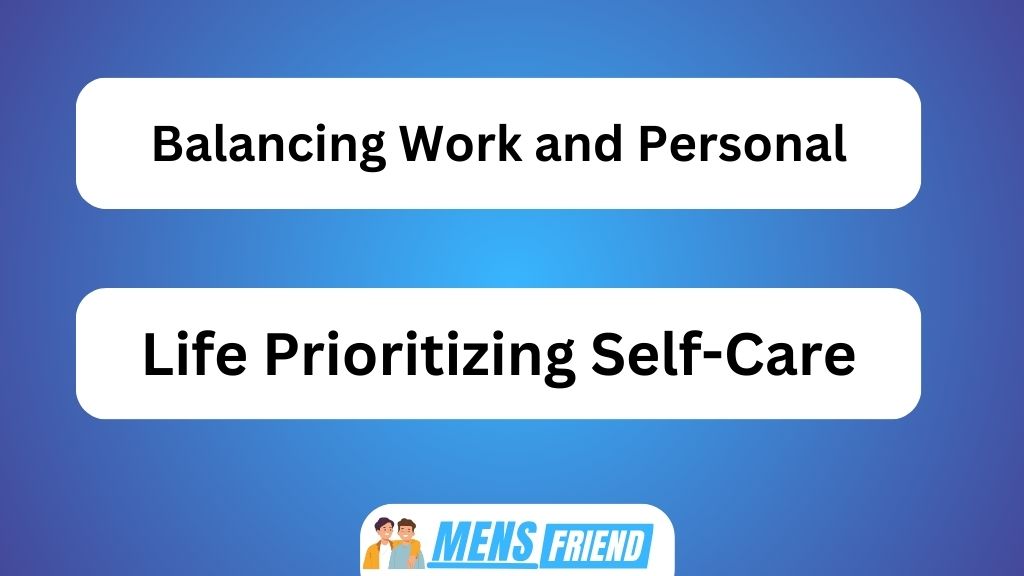We all know the struggle of trying to juggle work and personal life. It feels like a never-ending battle, constantly leaving us exhausted and overwhelmed. But here’s the truth: setting boundaries is the key to achieving a healthy work-life balance.

In this article, we will explore practical strategies for defining our priorities, managing stressors, and communicating expectations with our employers.
By learning to say no, finding support in our personal lives, and designating work-free zones at home, we can embrace flexibility and create a harmonious balance between work and personal life.
Key Takeaways of Balancing Work and Personal Life
- Establishing clear boundaries between work and personal life is important for achieving work-life balance.
- Defining work boundaries allows for separation of professional and personal responsibilities.
- Setting working hours and creating designated work spaces are effective ways to define work boundaries.
- Maintaining work-life balance prevents burnout, reduces stress levels, and enhances productivity.
The Importance of Boundaries in Work-Life Balance
You need to establish clear boundaries between your work and personal life if you want to maintain a healthy work-life balance. Defining work boundaries is essential for maintaining work-life balance because it allows you to create a separation between your professional and personal responsibilities. Without these boundaries, it becomes challenging to switch off from work and fully engage in your personal life.
Setting clear limits on your working hours, creating designated spaces for work, and establishing specific time slots for relaxation are effective ways of defining work boundaries. By doing so, you can ensure that you have dedicated time for both your professional obligations and personal activities.

Maintaining work-life balance is crucial for overall well-being. It helps prevent burnout, reduces stress levels, and enhances productivity in both areas of life. Remember that setting boundaries is not about neglecting one aspect over the other but rather finding a harmonious integration that allows you to thrive in both realms.
Defining Your Work-Life Balance Priorities
Defining your priorities for work-life balance helps establish clear boundaries. When it comes to achieving a healthy integration of work and personal life, it’s crucial to identify potential conflicts that may arise. By understanding what matters most to us in both areas, we can better allocate our time and energy accordingly.
To begin, take a step back and reflect on your values and goals. What is truly important to you? Is it spending quality time with loved ones, pursuing personal hobbies, or excelling in your career? Once you have identified these priorities, you can create strategies that promote work-life integration.

One effective strategy is setting realistic expectations for yourself and others. Communicate openly with your colleagues about your boundaries and availability outside of working hours. Additionally, learn to delegate tasks when possible to avoid becoming overwhelmed.
Another strategy involves creating designated spaces for work and personal life. Establishing physical boundaries between the two can help maintain focus during working hours while allowing you to fully disconnect when it’s time for personal activities.
Overall, defining your priorities is essential in finding the right balance between work and personal life. By identifying potential conflicts and implementing effective strategies for integration, you can lead a more fulfilling and balanced lifestyle.
Creating a Schedule That Works for You
When it comes to creating a schedule that works for us, there are three key factors to consider:
- Prioritizing daily tasks: This helps us stay focused on what needs to be done and ensures that we make progress towards our goals.
- Flexibility in time management: This allows us to adapt our schedule as needed and make room for unexpected events or opportunities.
- Maintaining work-life boundaries: This is crucial in order to prevent burnout and maintain a healthy balance between our personal and professional lives.
Prioritizing Daily Tasks
To prioritize our daily tasks, it’s important to develop a clear plan and stick to it. Here are four time management strategies that can help us achieve this:
- Set realistic goals: By setting achievable goals for ourselves, we can avoid becoming overwhelmed and ensure that we have enough time for self-care activities.
- Prioritize self-care: Taking care of ourselves should be at the top of our daily task list. Whether it’s exercising, meditating, or spending quality time with loved ones, prioritizing self-care allows us to recharge and be more productive.
- Use a task management system: Utilize tools such as calendars or productivity apps to keep track of all your tasks and deadlines. This will help you stay organized and ensure nothing falls through the cracks.
- Break tasks into smaller steps: Big projects can feel daunting, but breaking them down into smaller, manageable tasks makes them more approachable and less overwhelming.
Flexibility in Time Management
You can incorporate flexibility into your time management by allowing for unexpected changes and adjusting your schedule accordingly. In today’s fast-paced work environment, it is crucial to have the ability to adapt and be open to change.
Flexible work arrangements are becoming increasingly popular as they allow individuals to have more control over their schedules. One effective strategy is time blocking, where you allocate specific blocks of time for different tasks or activities. This approach not only helps you stay focused but also allows room for flexibility when unforeseen circumstances arise.
Maintaining Work-Life Boundaries
Maintaining a healthy work-life boundary requires finding strategies that allow for flexibility and adaptability. Here are four practical ways to achieve work-life integration while setting clear work boundaries:
- Prioritize self-care: Make time for activities that rejuvenate and recharge you, such as exercising, practicing mindfulness, or pursuing hobbies. This helps maintain a healthy balance between work and personal life.
- Establish non-negotiables: Determine specific times or days when work is off-limits. Communicate these boundaries clearly to your colleagues and clients, ensuring they understand the importance of your personal time.
- Delegate and collaborate: Don’t be afraid to ask for help or delegate tasks when necessary. Collaborating with others can reduce workload and prevent burnout.
- Set realistic expectations: Be honest with yourself about what you can realistically accomplish within a given timeframe. Avoid overcommitting by learning to say no when needed.
By implementing these strategies, you can achieve better work-life integration while maintaining clear boundaries.
Now, let’s explore how to identify and manage work-related stressors in order to further enhance your overall well-being.
Identifying and Managing Work-Related Stressors
Identifying and managing work-related stressors can be challenging, but it’s essential for maintaining a healthy work-life balance.
When it comes to managing stress at work, one key aspect is recognizing the sources of stress. This could include high workload, tight deadlines, difficult colleagues or supervisors, or lack of control over one’s work. By identifying these stressors, we can take steps to effectively manage them.

Work life integration plays a crucial role in this process. It involves finding ways to integrate our personal and professional lives in a harmonious manner. This could mean setting clear boundaries between work and personal time, prioritizing self-care activities outside of work hours, and establishing open communication with colleagues about workload and expectations.
Implementing strategies such as time management techniques, practicing mindfulness or meditation during breaks, and seeking support from colleagues or mentors are also valuable tools in managing work-related stressors. Remember that everyone’s experience with stress is unique, so it may require some trial-and-error to find what works best for you.
Overall, by being proactive in identifying and managing our work-related stressors through effective strategies like work life integration techniques, we can achieve a healthier balance between our professional responsibilities and personal well-being.
Setting Clear Expectations With Your Employer
When it comes to achieving a healthy work-life balance, there are three key points that we need to consider.
First, negotiating work-life boundaries involves setting clear expectations with our employers about when and where we can be reached outside of regular working hours. This helps establish a separation between our professional and personal lives, allowing us to have dedicated time for ourselves and our loved ones.
Second, establishing communication guidelines is crucial in striking the right balance between being accessible and maintaining personal time. This means finding a middle ground where we are available for work-related matters, but also have the freedom to disconnect and focus on our personal lives without constant interruptions.
Lastly, defining a realistic workload is essential for maintaining our well-being while still meeting our professional obligations. This involves setting manageable tasks and deadlines that allow us to work efficiently without feeling overwhelmed or sacrificing our personal time. It’s important to prioritize our mental and physical health by not taking on more than we can handle.
Negotiating Work-Life Boundaries
Setting clear boundaries between your work and personal life is essential for achieving a healthy work-life balance. It can be challenging to negotiate these boundaries, but with the right communication strategies, it is possible.
Here are four key points to consider:
- Self-reflection: Take time to reflect on what you need in terms of work-life balance. Determine your priorities and non-negotiables.
- Open dialogue: Initiate a conversation with your employer or colleagues about your boundaries and expectations. Clearly communicate what you need to maintain a healthy balance.
- Flexibility: Be willing to compromise and find solutions that work for both parties. Flexibility can help create a win-win situation.
- Consistency: Once you have established your boundaries, stick to them consistently. This will reinforce their importance and ensure they are respected.
Establishing Communication Guidelines
To effectively establish communication guidelines, make sure you clearly communicate your expectations and needs to your employer or colleagues.
Establishing healthy communication is crucial for maintaining a productive work-life balance, especially in remote work settings.
With the rise of remote work, effective remote communication has become essential for maintaining collaboration and staying connected with team members.
Start by setting clear boundaries for communication, such as determining specific hours when you are available and when you need uninterrupted time for personal tasks or family commitments.
Use technology tools like email, instant messaging platforms, or video conferencing to stay connected and share updates with your team.
Regularly check-in with colleagues to ensure everyone is on the same page and address any concerns promptly.
Defining Realistic Workload
You should assess your workload realistically to ensure that you can effectively manage your tasks and meet deadlines without feeling overwhelmed.
Here are four reasons why defining a realistic workload is crucial for maintaining work-life balance:
- Avoid Burnout: Taking on too much work can lead to burnout, causing physical and mental exhaustion, decreased productivity, and strained relationships.
- Prioritize Personal Time: By accurately assessing your workload, you can carve out time for personal activities such as hobbies, exercise, or spending quality time with loved ones.
- Maintain Mental Well-being: Overloading yourself with unrealistic deadlines and excessive tasks can increase stress levels and negatively impact your mental health.
- Achieve Work-Life Balance: Balancing work demands with personal priorities allows you to have a fulfilling personal life while still excelling in your professional endeavors.
Establishing Non-Negotiable Personal Time
Make sure that you prioritize your non-negotiable personal time when establishing a work-life balance. Setting boundaries is crucial to ensure that you have time for yourself and your well-being. Non-negotiable boundaries are the lines you draw that cannot be crossed, protecting your personal time from being encroached upon by work demands. These boundaries can include specific hours dedicated solely to personal activities or days off where work-related tasks are strictly off-limits.
In addition to setting non-negotiable boundaries, incorporating self-care practices into your routine is essential for maintaining a healthy work-life balance. Self-care can take various forms such as exercise, meditation, spending quality time with loved ones, or pursuing hobbies and interests. It’s important to find activities that rejuvenate and recharge you, allowing you to disconnect from work and focus on taking care of yourself.
Learning to Say No and Prioritize Your Well-being
Learning to say no and prioritize your well-being can be challenging, but it is crucial for maintaining a healthy work-life balance. Here are four self-care strategies to help you say no gracefully:
- Set boundaries: Clearly define your limits and communicate them assertively yet respectfully. Remember that saying no does not make you selfish; it shows that you value yourself and your well-being.
- Prioritize tasks: Assess the importance and urgency of each request before committing to it. Learn to differentiate between what is essential and what can wait, allowing yourself the freedom to focus on what truly matters.
- Practice self-reflection: Take time to understand your needs, desires, and limitations. Reflecting on these aspects will enable you to better align your decisions with your personal goals and values.
- Seek support: Surround yourself with people who understand the importance of work-life balance and encourage your efforts in prioritizing self-care. Their support will reinforce your commitment to saying no when necessary.
Finding Support and Accountability in Your Personal Life
When it comes to building strong relationships and seeking emotional guidance, we believe that having a support system is essential.
It’s important to surround ourselves with people who uplift us and provide a safe space for us to express our emotions.
Building Strong Relationships
Having strong relationships in our lives is essential for a healthy work-life balance. Building and maintaining these relationships not only brings us joy and fulfillment, but also provides us with the support we need to navigate the challenges of balancing our professional and personal lives.
Here are four key reasons why investing in strong relationships can greatly enhance our work-life balance:
- Emotional support: Having close relationships allows us to share our joys and burdens, providing emotional support when we face stress or challenges at work.
- Perspective and advice: Trusted friends or family members can offer valuable insights and advice that help us make better decisions about setting boundaries between work and personal life.
- Accountability: Strong relationships can help hold us accountable to maintaining those boundaries, ensuring we prioritize self-care and quality time with loved ones.
- Work-life integration: Building connections across different areas of our lives helps create a sense of harmony between our professional and personal spheres, allowing for a more balanced existence overall.
Seeking Emotional Guidance
If you’re feeling overwhelmed or unsure about a decision, reaching out to trusted friends or family members can provide you with valuable emotional guidance.
Seeking emotional support is an essential aspect of maintaining mental and emotional well-being. Sometimes, when we are faced with challenging situations or decisions, it can be difficult to see things clearly on our own. That’s where seeking guidance from others comes in.
Trusted individuals can offer a fresh perspective, share their experiences, and provide comfort during moments of uncertainty. They can help us process our emotions and gain clarity on the best course of action.
Designating Work-Free Zones in Your Home
To establish a healthy work-life balance, make sure you’ve designated specific areas in your home where work is off-limits. Creating designated spaces for work-free zones can greatly improve your mental and emotional well-being.
Here are four reasons why establishing work-free zones in your home is essential:
- Enhanced relaxation: Having a separate space dedicated to relaxation allows you to disconnect from work and unwind, promoting better mental health.
- Improved focus: By designating specific areas for work, you create an environment that helps you concentrate better and be more productive during working hours.
- Strengthened relationships: Setting boundaries between work and personal life enables you to spend quality time with loved ones without distractions, fostering stronger relationships.
- Increased self-care: Having designated areas for non-work activities encourages self-care practices like exercising, reading, or pursuing hobbies that contribute to overall well-being.
Embracing Flexibility and Adaptability in Work-Life Balance
Embrace the flexibility and adaptability that comes with finding a healthy work-life balance. In today’s fast-paced world, embracing remote work opportunities has become more prevalent than ever. With advancements in technology, we now have the ability to work from anywhere, allowing us to maintain a fulfilling career while exploring new places and experiences.
Finding work-life balance during travel can be challenging, but it is certainly not impossible. By prioritizing tasks and setting clear boundaries, we can ensure that our personal time is not compromised by work obligations. Planning ahead and making use of available resources such as coworking spaces or local cafes can help create a productive working environment while on the road.
Frequently Asked Questions
How Can I Effectively Communicate My Boundaries to My Colleagues and Employer?
We can effectively communicate our boundaries by setting clear expectations with colleagues and employers. It is important to have open and honest conversations, establish limits, and reinforce them consistently to maintain a healthy work-life balance.
What Are Some Strategies for Managing Work-Related Stress Outside of Regular Working Hours?
Work life balance strategies can help us cope with work-related stress outside of regular working hours. Setting clear boundaries, practicing self-care, and prioritizing tasks effectively are some effective strategies for managing work-related stress.
How Do I Balance My Personal Life With a Demanding Job That Requires Long Hours?
To balance our personal lives with demanding jobs that require long hours, we prioritize self-care by setting boundaries and carving out time for activities we enjoy. We also find support systems through friends, family, and colleagues who understand the challenges we face.
Are There Any Specific Tools or Resources That Can Help Me Maintain a Healthy Work-Life Balance?
There are various tools and resources available to help us maintain a healthy work-life balance. These include time management apps, wellness programs, and support networks. Implementing these strategies can assist in managing work-related stress and improving overall well-being.
How Can I Navigate Work-Life Balance When Working Remotely or From Home?
Navigating work-life balance when working remotely or from home can pose challenges. However, creating a dedicated workspace and setting clear boundaries can help us maintain a healthy balance between our professional and personal lives.
Conclusion
In conclusion, setting boundaries is the key to achieving a harmonious work-life balance. Just as a symphony conductor directs each instrument to play their part at the right moment, we too must orchestrate our lives in a way that allows for both work and personal fulfillment.
By defining our priorities, creating a schedule that suits us, managing stressors, and communicating clear expectations with our employers, we can find harmony in our daily lives.
Remember, finding support, embracing flexibility, and designating work-free zones are all essential notes in this beautiful melody of work-life balance.





